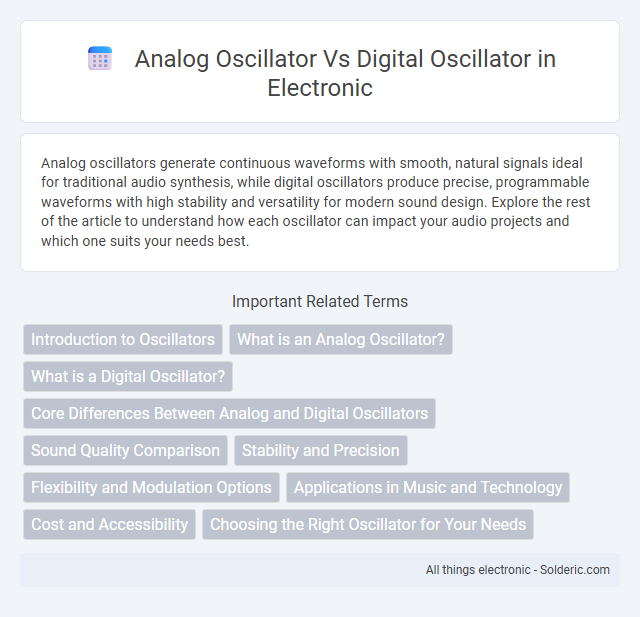Analog oscillators generate continuous waveforms with smooth, natural signals ideal for traditional audio synthesis, while digital oscillators produce precise, programmable waveforms with high stability and versatility for modern sound design. Explore the rest of the article to understand how each oscillator can impact your audio projects and which one suits your needs best.
Comparison Table
| Feature | Analog Oscillator | Digital Oscillator |
|---|---|---|
| Signal Type | Continuous waveform (sine, square, triangle) | Discrete digital waveform (sampled signals) |
| Frequency Stability | Moderate; affected by temperature and component aging | High; precise and stable using digital clock sources |
| Waveform Flexibility | Limited by circuit design | Highly flexible; can generate complex waveforms via software |
| Power Consumption | Generally higher due to analog components | Lower, optimized via digital processing |
| Noise Sensitivity | Susceptible to analog noise and interference | Less prone to noise due to digital signals |
| Cost | Lower initial cost for simple oscillators | Higher initial cost; scalable with complexity |
| Applications | Analog radios, synthesizers, traditional signal generation | Digital synthesizers, software-defined radios, modern communications |
Introduction to Oscillators
Analog oscillators generate continuous waveforms using components like capacitors and inductors, producing smooth and natural signals ideal for audio and radio frequency applications. Digital oscillators create waveforms through discrete steps via algorithms or digital counters, offering precision and stability crucial for modern synthesizers and communication systems. Your choice of oscillator depends on the desired tone quality, signal accuracy, and application requirements.
What is an Analog Oscillator?
An analog oscillator generates continuous waveforms, such as sine, square, or triangle waves, using reactive components like capacitors and inductors in electronic circuits. It relies on feedback loops and LC circuits or RC timing elements to maintain stable frequency oscillations without discrete steps. These oscillators are essential in radio frequency transmission, audio synthesis, and timing applications where smooth, natural signal variations are required.
What is a Digital Oscillator?
A digital oscillator generates waveforms using numerical algorithms and digital signal processing techniques, offering precise frequency control and stability. Unlike analog oscillators that rely on electronic components like capacitors and inductors, digital oscillators produce sound waves through microprocessors or digital circuits. Their ability to replicate complex waveforms with minimal distortion makes them essential in modern synthesizers and electronic music production.
Core Differences Between Analog and Digital Oscillators
Analog oscillators generate continuous waveforms using components such as capacitors, inductors, and transistors, resulting in natural, smooth signals with inherent noise and drift. Digital oscillators produce discrete waveforms through algorithms and digital signal processing, offering precise frequency control, stability, and programmability. Your choice depends on whether you prioritize organic sound characteristics or exact, reliable waveform generation.
Sound Quality Comparison
Analog oscillators produce richer, warmer tones due to their continuous waveform generation and natural harmonic distortion, favored in classic synthesizers and professional audio applications. Digital oscillators offer precise frequency control and stability, enabling highly complex waveforms and extensive modulation but can sometimes introduce aliasing artifacts affecting sound purity. The choice between analog and digital oscillators significantly impacts sound quality, with analog preferred for organic textures and digital for versatility and consistency in modern music production.
Stability and Precision
Analog oscillators often experience frequency drift due to temperature variations and component aging, resulting in lower stability and precision compared to digital oscillators. Digital oscillators use precise clock signals and can employ temperature-compensated or crystal-based references, ensuring enhanced frequency accuracy and long-term stability. Your choice between analog and digital oscillators should consider these factors when stability and precision are critical for the application.
Flexibility and Modulation Options
Analog oscillators offer rich, organic sound textures with continuous waveform variations and intuitive modulation through voltage control. Digital oscillators provide extensive flexibility, featuring complex waveforms, precise tuning, and advanced modulation capabilities like frequency modulation (FM) and wavetable synthesis. Your choice depends on whether you prioritize the warm, hands-on modulation of analog or the vast, programmable options available in digital synthesis.
Applications in Music and Technology
Analog oscillators generate continuous waveforms with natural warmth ideal for classic synthesizers, providing rich harmonic textures favored in vintage music production and sound design. Digital oscillators offer precise waveform control, stability, and versatility, enabling complex modulation and integration into modern music software, virtual instruments, and advanced audio processing technologies. Your choice between analog and digital oscillators impacts tonal character and flexibility across music production, sound synthesis, and electronic device applications.
Cost and Accessibility
Analog oscillators typically have lower initial costs and are readily accessible for basic applications due to simpler circuitry and readily available components. Digital oscillators often require more advanced hardware and software, increasing production costs but offering greater precision and programmability. Your choice depends on balancing budget constraints with the need for accuracy and functionality in your project.
Choosing the Right Oscillator for Your Needs
Selecting the right oscillator depends on your application's precision and stability requirements, with analog oscillators offering smooth signal generation ideal for audio and RF applications, while digital oscillators provide higher frequency stability and programmability suitable for clocks and data communication. Analog oscillators, such as LC or RC types, excel in producing continuous waveforms but may suffer from temperature drift and component tolerances. Digital oscillators leverage crystal or MEMS technology for accurate frequency control, ensuring your system performs reliably under varying environmental conditions.
analog oscillator vs digital oscillator Infographic

 solderic.com
solderic.com